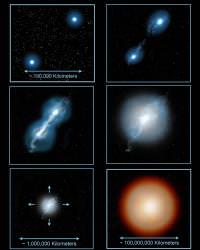 Of all the stars in our galaxy, two classes, known as hydrogen-deficient and R Coronae Borealis are extremely rare. Only a few dozen have been discovered in our entire galaxy. And unlike most of the stars out there, they have almost no hydrogen. Instead, they have abnormally high quantities of a rare isotope of oxygen.
Of all the stars in our galaxy, two classes, known as hydrogen-deficient and R Coronae Borealis are extremely rare. Only a few dozen have been discovered in our entire galaxy. And unlike most of the stars out there, they have almost no hydrogen. Instead, they have abnormally high quantities of a rare isotope of oxygen.
Continue reading “Colliding White Dwarfs Could Create a Supergiant Star”
Superstrings Could Be Detectable As They Decay
 One of Einstein’s predictions for relativity is the concept of gravity waves; these are emitted whenever massive objects move. The more massive the object the stronger the gravity wave.
One of Einstein’s predictions for relativity is the concept of gravity waves; these are emitted whenever massive objects move. The more massive the object the stronger the gravity wave.
Continue reading “Superstrings Could Be Detectable As They Decay”
Hubble Sees a Hypergiant Star Nearing Death
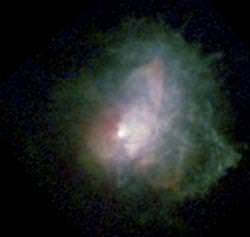 VY Canis Majoris, located about 5,000 light-years away, is no ordinary star; it’s a supergiant, containing 30 to 40 times the mass of our own Sun. And it’s so luminous it’s also considered a hypergiant, shining 500,000 times as bright as the Sun. And it’s big… really big. If this star lived in our Solar System, its surface would extend out to the orbit of Saturn.
VY Canis Majoris, located about 5,000 light-years away, is no ordinary star; it’s a supergiant, containing 30 to 40 times the mass of our own Sun. And it’s so luminous it’s also considered a hypergiant, shining 500,000 times as bright as the Sun. And it’s big… really big. If this star lived in our Solar System, its surface would extend out to the orbit of Saturn.
Continue reading “Hubble Sees a Hypergiant Star Nearing Death”
The Milky Way and the Seven Dwarfs
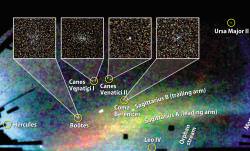 There’s no easy way to put this, our home galaxy is a killer. It’s torn up galaxies in the past, and it’s going to do it again in the future. Each galaxy we consume makes us larger. If you need evidence that this is still going on, you only need to look at the conveyor belt of dwarf galaxies orbiting the Milky Way; each of which will eventually get torn apart, its stars assimilated.
There’s no easy way to put this, our home galaxy is a killer. It’s torn up galaxies in the past, and it’s going to do it again in the future. Each galaxy we consume makes us larger. If you need evidence that this is still going on, you only need to look at the conveyor belt of dwarf galaxies orbiting the Milky Way; each of which will eventually get torn apart, its stars assimilated.
Continue reading “The Milky Way and the Seven Dwarfs”
Eagle Nebula’s Pillars Were Wiped Out Thousands of Years Ago
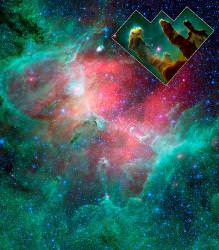 One of the most famous space photographs ever taken is the “Pillars of Creation” by Hubble, an amazing image of the Eagle nebula. But a new image from the Spitzer Space Telescope provides evidence that those towers of gas and dust might have already been wiped away.
One of the most famous space photographs ever taken is the “Pillars of Creation” by Hubble, an amazing image of the Eagle nebula. But a new image from the Spitzer Space Telescope provides evidence that those towers of gas and dust might have already been wiped away.
Continue reading “Eagle Nebula’s Pillars Were Wiped Out Thousands of Years Ago”
Open Star Clusters Die Young
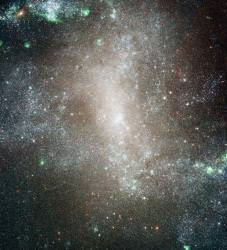 Massive globular clusters are some of the oldest objects in the Universe, held together by the collective gravity of their stars. Open star clusters, on the other hand, don’t live so long.
Massive globular clusters are some of the oldest objects in the Universe, held together by the collective gravity of their stars. Open star clusters, on the other hand, don’t live so long.
Continue reading “Open Star Clusters Die Young”
A New View of Kepler’s Supernova Remnant
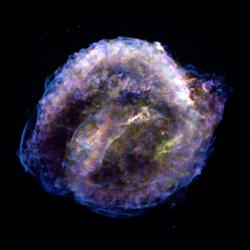 NASA’s Chandra X-Ray Observatory has created this amazing image of one of the youngest supernova remnants in the galaxy. The supernova that created it blazed in the sky more than 400 years ago, before the telescope had even been invented. No problem, though, it was bright enough that you didn’t need a telescope – it reached the brightness of Jupiter at its peak. And one of the greatest astronomers in history, Johannes Kepler was there to see it.
NASA’s Chandra X-Ray Observatory has created this amazing image of one of the youngest supernova remnants in the galaxy. The supernova that created it blazed in the sky more than 400 years ago, before the telescope had even been invented. No problem, though, it was bright enough that you didn’t need a telescope – it reached the brightness of Jupiter at its peak. And one of the greatest astronomers in history, Johannes Kepler was there to see it.
Continue reading “A New View of Kepler’s Supernova Remnant”
Blizzard of Snowflake Particles Around a Young Star
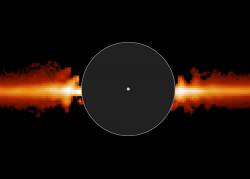 The Hubble Space Telescope has imaged a ring of dust around a nearby star that will probably become a system of planets. The star is AU Microscopii, and it’s located about 32 light-years away in the southern constellation of Microscopium (the Microscope). The particles are probably as fluffy as snowflakes, and about 10 times larger than typical interstellar dust grains.
The Hubble Space Telescope has imaged a ring of dust around a nearby star that will probably become a system of planets. The star is AU Microscopii, and it’s located about 32 light-years away in the southern constellation of Microscopium (the Microscope). The particles are probably as fluffy as snowflakes, and about 10 times larger than typical interstellar dust grains.
Continue reading “Blizzard of Snowflake Particles Around a Young Star”
Hubble Helps Make a 3-D Map of Dark Matter
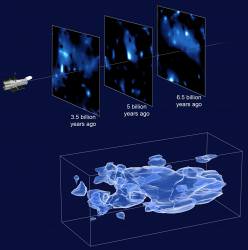 A team of astronomers has created a three-dimensional map of dark matter distribution across the Universe. This map gives some of the best evidence that normal matter, like you and me, stars and planets, accumulate around the densest regions of dark matter.
A team of astronomers has created a three-dimensional map of dark matter distribution across the Universe. This map gives some of the best evidence that normal matter, like you and me, stars and planets, accumulate around the densest regions of dark matter.
Continue reading “Hubble Helps Make a 3-D Map of Dark Matter”
First Triple Quasar Discovered
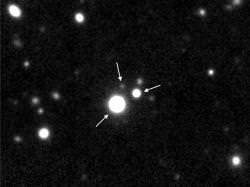 Quasars are some of the brightest objects in the Universe, beaming radiation across billions of light-years of space. Although they were a mystery for many years, astronomers now believe they’re the bright radiation from matter clogging up around an actively feeding supermassive black hole.
Quasars are some of the brightest objects in the Universe, beaming radiation across billions of light-years of space. Although they were a mystery for many years, astronomers now believe they’re the bright radiation from matter clogging up around an actively feeding supermassive black hole.
Continue reading “First Triple Quasar Discovered”
